Nike Versus new Balance Trade Policy in a World of Global Value Chains Assignment 2022
VerifiedAdded on 2022/10/07
|8
|1461
|14
Assignment
AI Summary
Contribute Materials
Your contribution can guide someone’s learning journey. Share your
documents today.
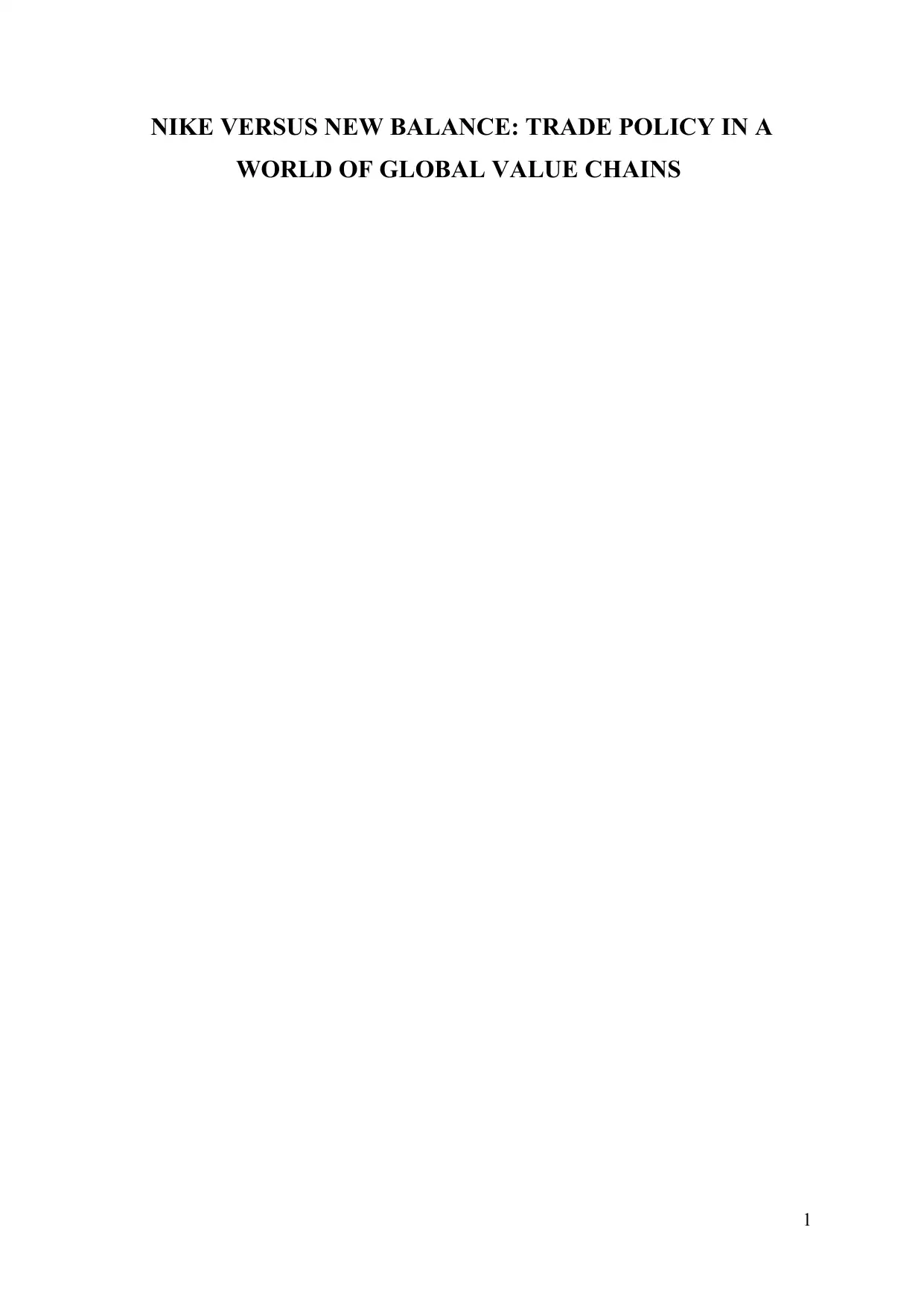
NIKE VERSUS NEW BALANCE: TRADE POLICY IN A
WORLD OF GLOBAL VALUE CHAINS
1
WORLD OF GLOBAL VALUE CHAINS
1
Secure Best Marks with AI Grader
Need help grading? Try our AI Grader for instant feedback on your assignments.
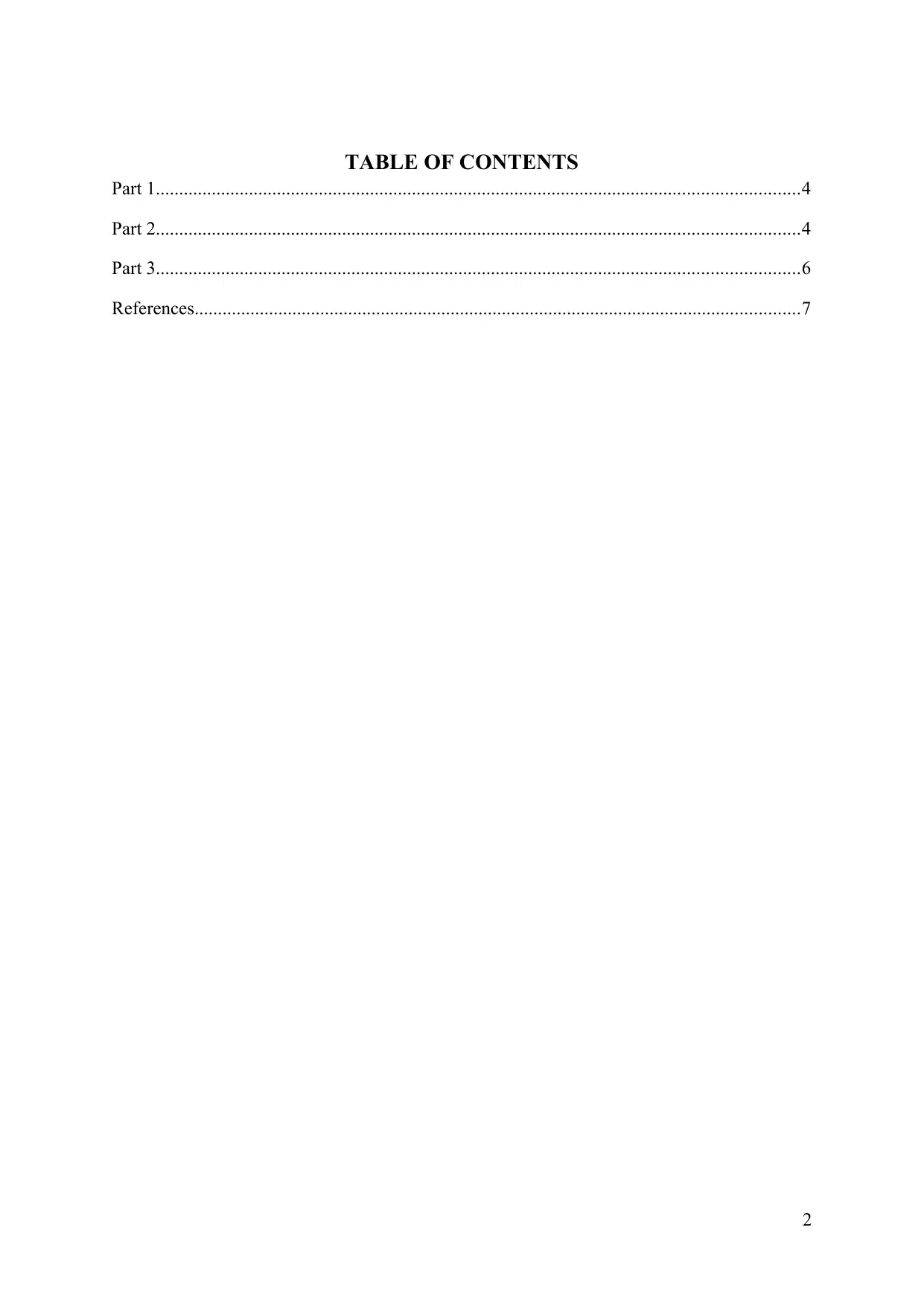
TABLE OF CONTENTS
Part 1..........................................................................................................................................4
Part 2..........................................................................................................................................4
Part 3..........................................................................................................................................6
References..................................................................................................................................7
2
Part 1..........................................................................................................................................4
Part 2..........................................................................................................................................4
Part 3..........................................................................................................................................6
References..................................................................................................................................7
2
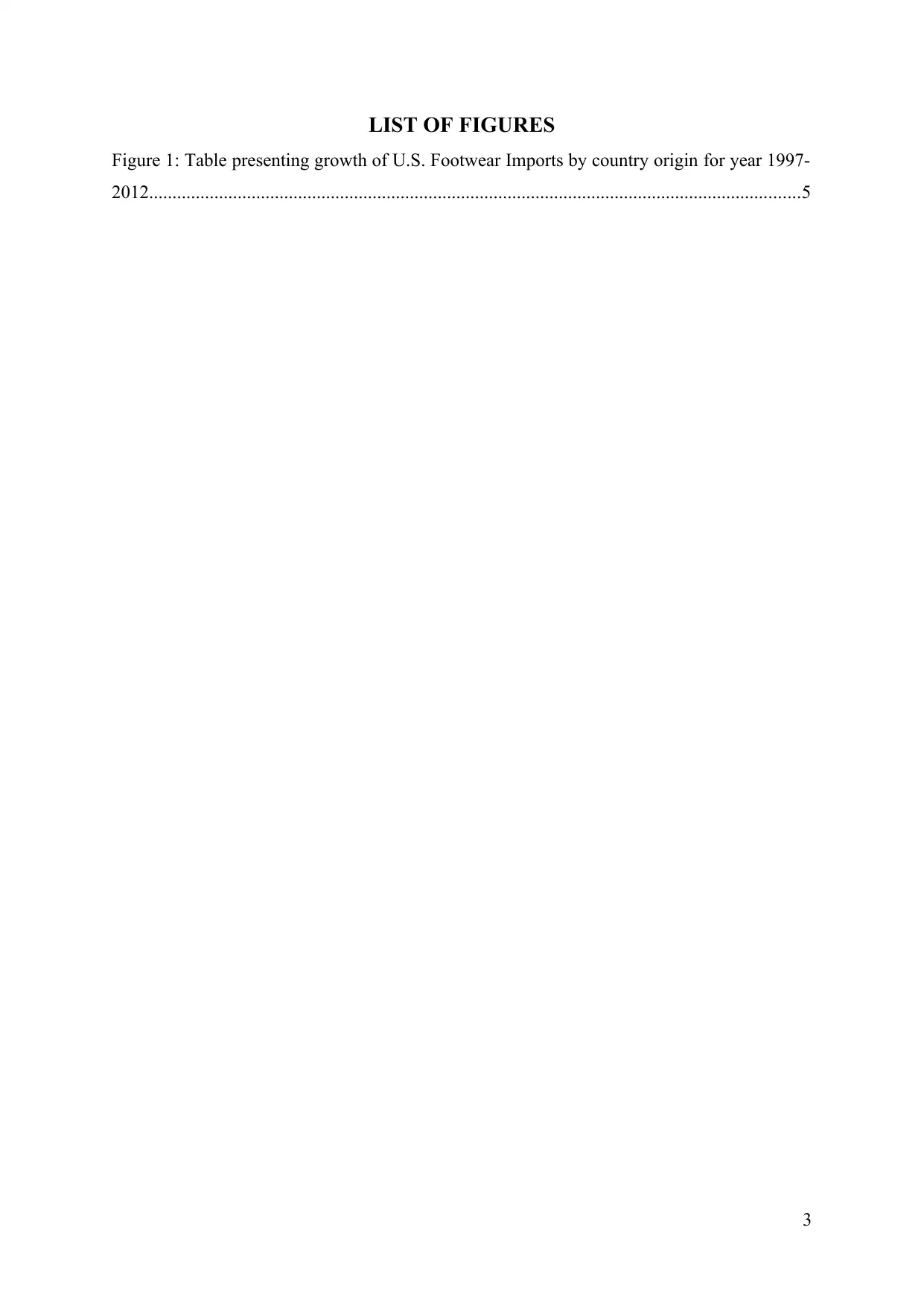
LIST OF FIGURES
Figure 1: Table presenting growth of U.S. Footwear Imports by country origin for year 1997-
2012............................................................................................................................................5
3
Figure 1: Table presenting growth of U.S. Footwear Imports by country origin for year 1997-
2012............................................................................................................................................5
3
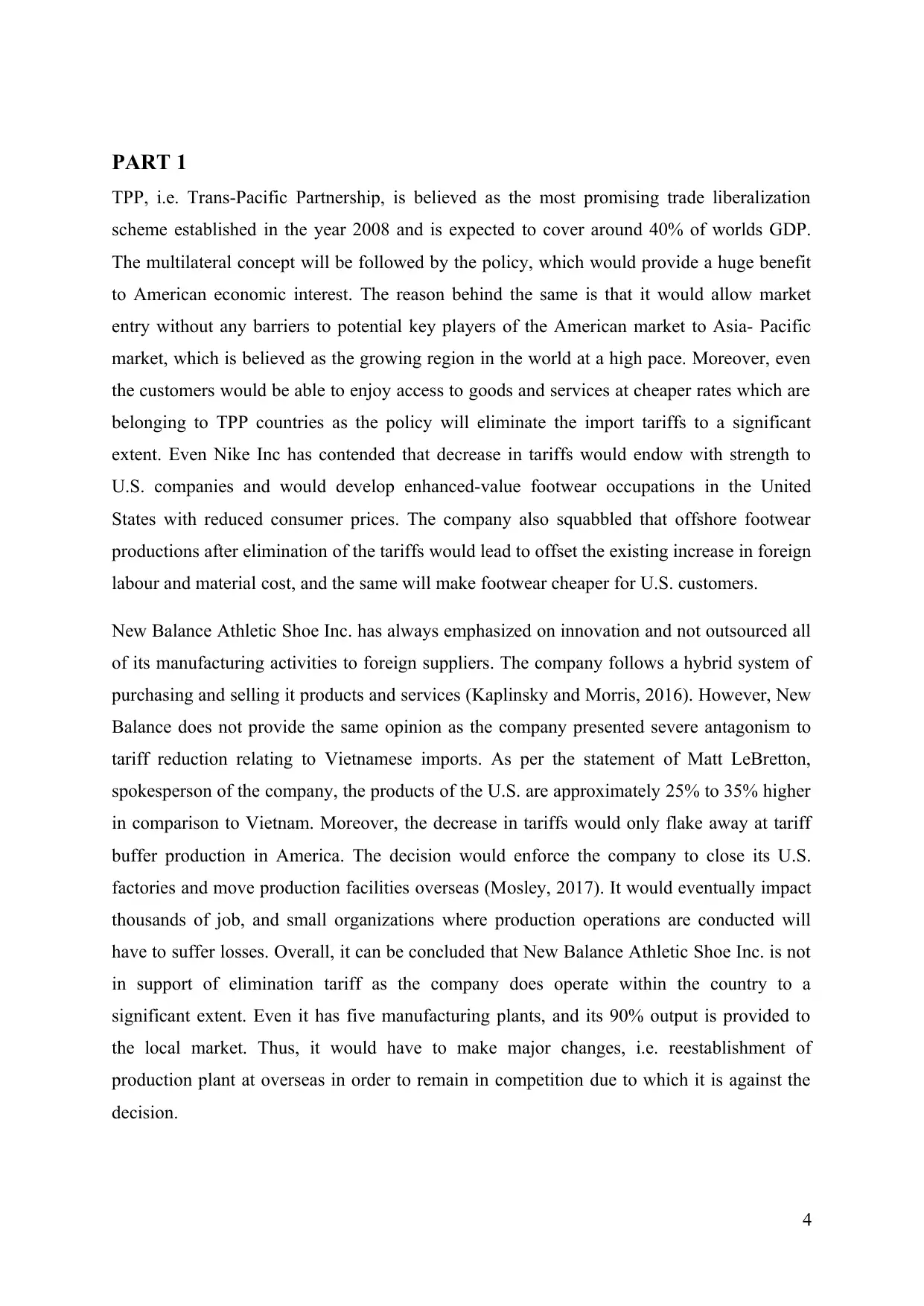
PART 1
TPP, i.e. Trans-Pacific Partnership, is believed as the most promising trade liberalization
scheme established in the year 2008 and is expected to cover around 40% of worlds GDP.
The multilateral concept will be followed by the policy, which would provide a huge benefit
to American economic interest. The reason behind the same is that it would allow market
entry without any barriers to potential key players of the American market to Asia- Pacific
market, which is believed as the growing region in the world at a high pace. Moreover, even
the customers would be able to enjoy access to goods and services at cheaper rates which are
belonging to TPP countries as the policy will eliminate the import tariffs to a significant
extent. Even Nike Inc has contended that decrease in tariffs would endow with strength to
U.S. companies and would develop enhanced-value footwear occupations in the United
States with reduced consumer prices. The company also squabbled that offshore footwear
productions after elimination of the tariffs would lead to offset the existing increase in foreign
labour and material cost, and the same will make footwear cheaper for U.S. customers.
New Balance Athletic Shoe Inc. has always emphasized on innovation and not outsourced all
of its manufacturing activities to foreign suppliers. The company follows a hybrid system of
purchasing and selling it products and services (Kaplinsky and Morris, 2016). However, New
Balance does not provide the same opinion as the company presented severe antagonism to
tariff reduction relating to Vietnamese imports. As per the statement of Matt LeBretton,
spokesperson of the company, the products of the U.S. are approximately 25% to 35% higher
in comparison to Vietnam. Moreover, the decrease in tariffs would only flake away at tariff
buffer production in America. The decision would enforce the company to close its U.S.
factories and move production facilities overseas (Mosley, 2017). It would eventually impact
thousands of job, and small organizations where production operations are conducted will
have to suffer losses. Overall, it can be concluded that New Balance Athletic Shoe Inc. is not
in support of elimination tariff as the company does operate within the country to a
significant extent. Even it has five manufacturing plants, and its 90% output is provided to
the local market. Thus, it would have to make major changes, i.e. reestablishment of
production plant at overseas in order to remain in competition due to which it is against the
decision.
4
TPP, i.e. Trans-Pacific Partnership, is believed as the most promising trade liberalization
scheme established in the year 2008 and is expected to cover around 40% of worlds GDP.
The multilateral concept will be followed by the policy, which would provide a huge benefit
to American economic interest. The reason behind the same is that it would allow market
entry without any barriers to potential key players of the American market to Asia- Pacific
market, which is believed as the growing region in the world at a high pace. Moreover, even
the customers would be able to enjoy access to goods and services at cheaper rates which are
belonging to TPP countries as the policy will eliminate the import tariffs to a significant
extent. Even Nike Inc has contended that decrease in tariffs would endow with strength to
U.S. companies and would develop enhanced-value footwear occupations in the United
States with reduced consumer prices. The company also squabbled that offshore footwear
productions after elimination of the tariffs would lead to offset the existing increase in foreign
labour and material cost, and the same will make footwear cheaper for U.S. customers.
New Balance Athletic Shoe Inc. has always emphasized on innovation and not outsourced all
of its manufacturing activities to foreign suppliers. The company follows a hybrid system of
purchasing and selling it products and services (Kaplinsky and Morris, 2016). However, New
Balance does not provide the same opinion as the company presented severe antagonism to
tariff reduction relating to Vietnamese imports. As per the statement of Matt LeBretton,
spokesperson of the company, the products of the U.S. are approximately 25% to 35% higher
in comparison to Vietnam. Moreover, the decrease in tariffs would only flake away at tariff
buffer production in America. The decision would enforce the company to close its U.S.
factories and move production facilities overseas (Mosley, 2017). It would eventually impact
thousands of job, and small organizations where production operations are conducted will
have to suffer losses. Overall, it can be concluded that New Balance Athletic Shoe Inc. is not
in support of elimination tariff as the company does operate within the country to a
significant extent. Even it has five manufacturing plants, and its 90% output is provided to
the local market. Thus, it would have to make major changes, i.e. reestablishment of
production plant at overseas in order to remain in competition due to which it is against the
decision.
4
Secure Best Marks with AI Grader
Need help grading? Try our AI Grader for instant feedback on your assignments.
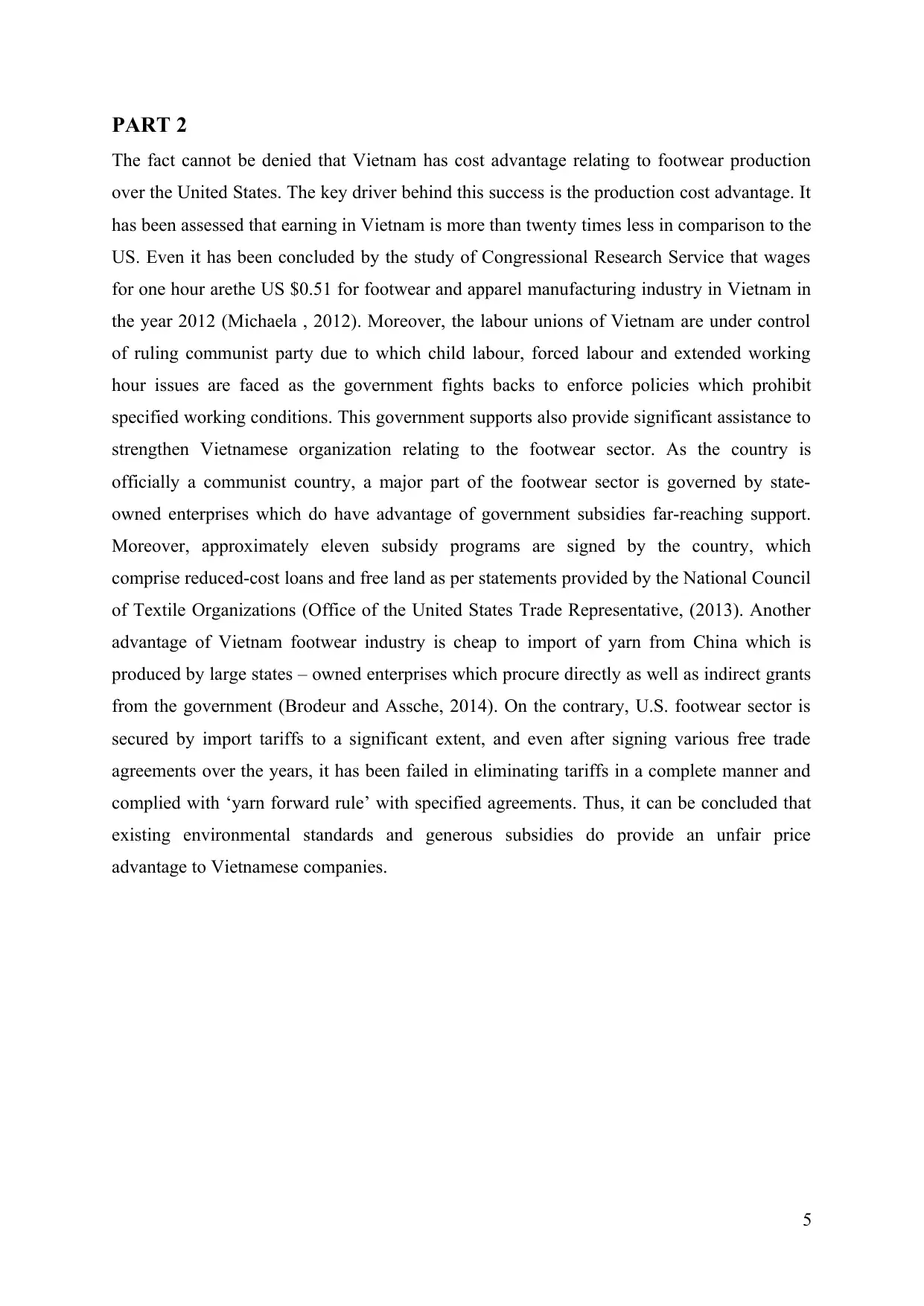
PART 2
The fact cannot be denied that Vietnam has cost advantage relating to footwear production
over the United States. The key driver behind this success is the production cost advantage. It
has been assessed that earning in Vietnam is more than twenty times less in comparison to the
US. Even it has been concluded by the study of Congressional Research Service that wages
for one hour arethe US $0.51 for footwear and apparel manufacturing industry in Vietnam in
the year 2012 (Michaela , 2012). Moreover, the labour unions of Vietnam are under control
of ruling communist party due to which child labour, forced labour and extended working
hour issues are faced as the government fights backs to enforce policies which prohibit
specified working conditions. This government supports also provide significant assistance to
strengthen Vietnamese organization relating to the footwear sector. As the country is
officially a communist country, a major part of the footwear sector is governed by state-
owned enterprises which do have advantage of government subsidies far-reaching support.
Moreover, approximately eleven subsidy programs are signed by the country, which
comprise reduced-cost loans and free land as per statements provided by the National Council
of Textile Organizations (Office of the United States Trade Representative, (2013). Another
advantage of Vietnam footwear industry is cheap to import of yarn from China which is
produced by large states – owned enterprises which procure directly as well as indirect grants
from the government (Brodeur and Assche, 2014). On the contrary, U.S. footwear sector is
secured by import tariffs to a significant extent, and even after signing various free trade
agreements over the years, it has been failed in eliminating tariffs in a complete manner and
complied with ‘yarn forward rule’ with specified agreements. Thus, it can be concluded that
existing environmental standards and generous subsidies do provide an unfair price
advantage to Vietnamese companies.
5
The fact cannot be denied that Vietnam has cost advantage relating to footwear production
over the United States. The key driver behind this success is the production cost advantage. It
has been assessed that earning in Vietnam is more than twenty times less in comparison to the
US. Even it has been concluded by the study of Congressional Research Service that wages
for one hour arethe US $0.51 for footwear and apparel manufacturing industry in Vietnam in
the year 2012 (Michaela , 2012). Moreover, the labour unions of Vietnam are under control
of ruling communist party due to which child labour, forced labour and extended working
hour issues are faced as the government fights backs to enforce policies which prohibit
specified working conditions. This government supports also provide significant assistance to
strengthen Vietnamese organization relating to the footwear sector. As the country is
officially a communist country, a major part of the footwear sector is governed by state-
owned enterprises which do have advantage of government subsidies far-reaching support.
Moreover, approximately eleven subsidy programs are signed by the country, which
comprise reduced-cost loans and free land as per statements provided by the National Council
of Textile Organizations (Office of the United States Trade Representative, (2013). Another
advantage of Vietnam footwear industry is cheap to import of yarn from China which is
produced by large states – owned enterprises which procure directly as well as indirect grants
from the government (Brodeur and Assche, 2014). On the contrary, U.S. footwear sector is
secured by import tariffs to a significant extent, and even after signing various free trade
agreements over the years, it has been failed in eliminating tariffs in a complete manner and
complied with ‘yarn forward rule’ with specified agreements. Thus, it can be concluded that
existing environmental standards and generous subsidies do provide an unfair price
advantage to Vietnamese companies.
5
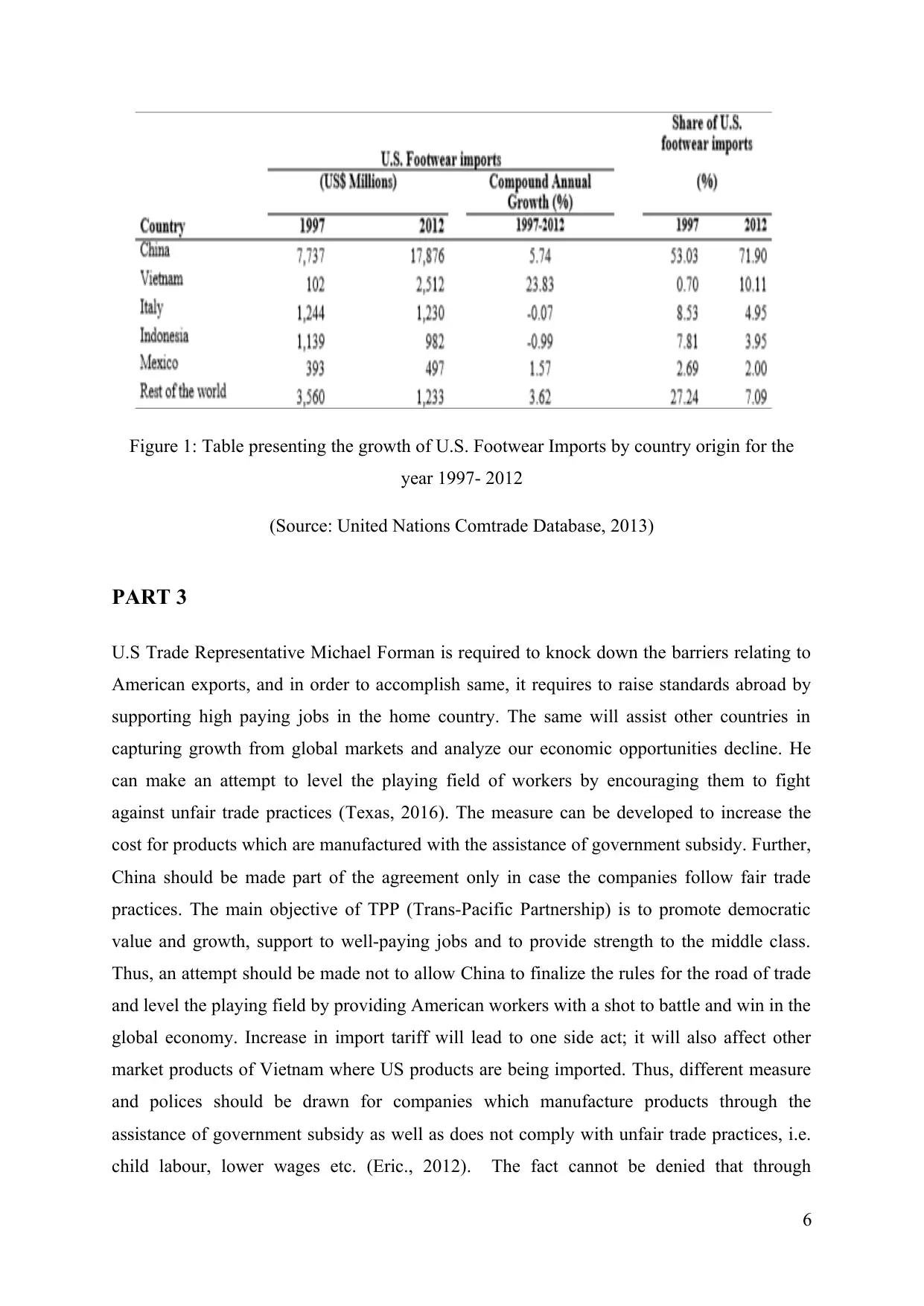
Figure 1: Table presenting the growth of U.S. Footwear Imports by country origin for the
year 1997- 2012
(Source: United Nations Comtrade Database, 2013)
PART 3
U.S Trade Representative Michael Forman is required to knock down the barriers relating to
American exports, and in order to accomplish same, it requires to raise standards abroad by
supporting high paying jobs in the home country. The same will assist other countries in
capturing growth from global markets and analyze our economic opportunities decline. He
can make an attempt to level the playing field of workers by encouraging them to fight
against unfair trade practices (Texas, 2016). The measure can be developed to increase the
cost for products which are manufactured with the assistance of government subsidy. Further,
China should be made part of the agreement only in case the companies follow fair trade
practices. The main objective of TPP (Trans-Pacific Partnership) is to promote democratic
value and growth, support to well-paying jobs and to provide strength to the middle class.
Thus, an attempt should be made not to allow China to finalize the rules for the road of trade
and level the playing field by providing American workers with a shot to battle and win in the
global economy. Increase in import tariff will lead to one side act; it will also affect other
market products of Vietnam where US products are being imported. Thus, different measure
and polices should be drawn for companies which manufacture products through the
assistance of government subsidy as well as does not comply with unfair trade practices, i.e.
child labour, lower wages etc. (Eric., 2012). The fact cannot be denied that through
6
year 1997- 2012
(Source: United Nations Comtrade Database, 2013)
PART 3
U.S Trade Representative Michael Forman is required to knock down the barriers relating to
American exports, and in order to accomplish same, it requires to raise standards abroad by
supporting high paying jobs in the home country. The same will assist other countries in
capturing growth from global markets and analyze our economic opportunities decline. He
can make an attempt to level the playing field of workers by encouraging them to fight
against unfair trade practices (Texas, 2016). The measure can be developed to increase the
cost for products which are manufactured with the assistance of government subsidy. Further,
China should be made part of the agreement only in case the companies follow fair trade
practices. The main objective of TPP (Trans-Pacific Partnership) is to promote democratic
value and growth, support to well-paying jobs and to provide strength to the middle class.
Thus, an attempt should be made not to allow China to finalize the rules for the road of trade
and level the playing field by providing American workers with a shot to battle and win in the
global economy. Increase in import tariff will lead to one side act; it will also affect other
market products of Vietnam where US products are being imported. Thus, different measure
and polices should be drawn for companies which manufacture products through the
assistance of government subsidy as well as does not comply with unfair trade practices, i.e.
child labour, lower wages etc. (Eric., 2012). The fact cannot be denied that through
6
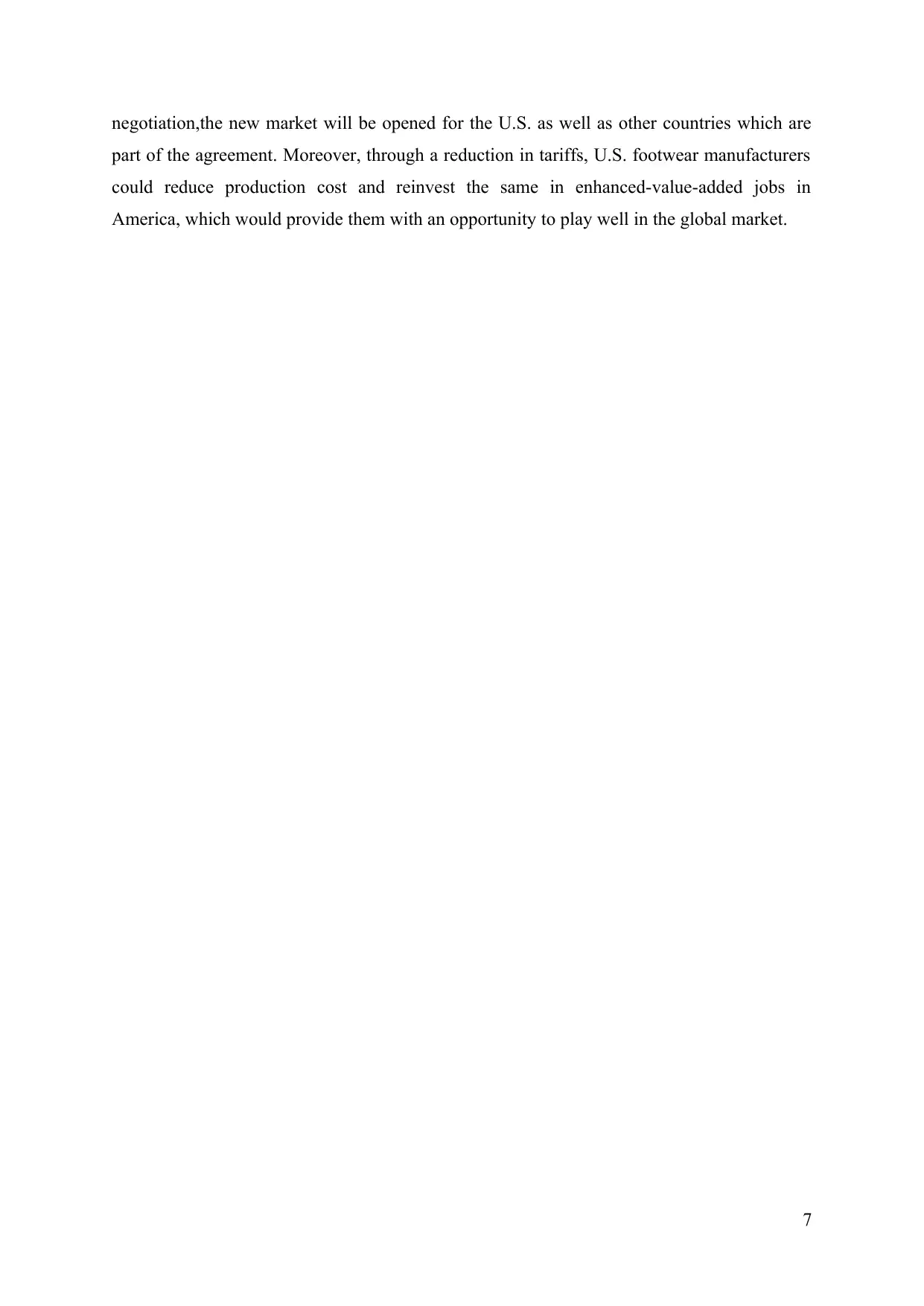
negotiation,the new market will be opened for the U.S. as well as other countries which are
part of the agreement. Moreover, through a reduction in tariffs, U.S. footwear manufacturers
could reduce production cost and reinvest the same in enhanced-value-added jobs in
America, which would provide them with an opportunity to play well in the global market.
7
part of the agreement. Moreover, through a reduction in tariffs, U.S. footwear manufacturers
could reduce production cost and reinvest the same in enhanced-value-added jobs in
America, which would provide them with an opportunity to play well in the global market.
7
Paraphrase This Document
Need a fresh take? Get an instant paraphrase of this document with our AI Paraphraser
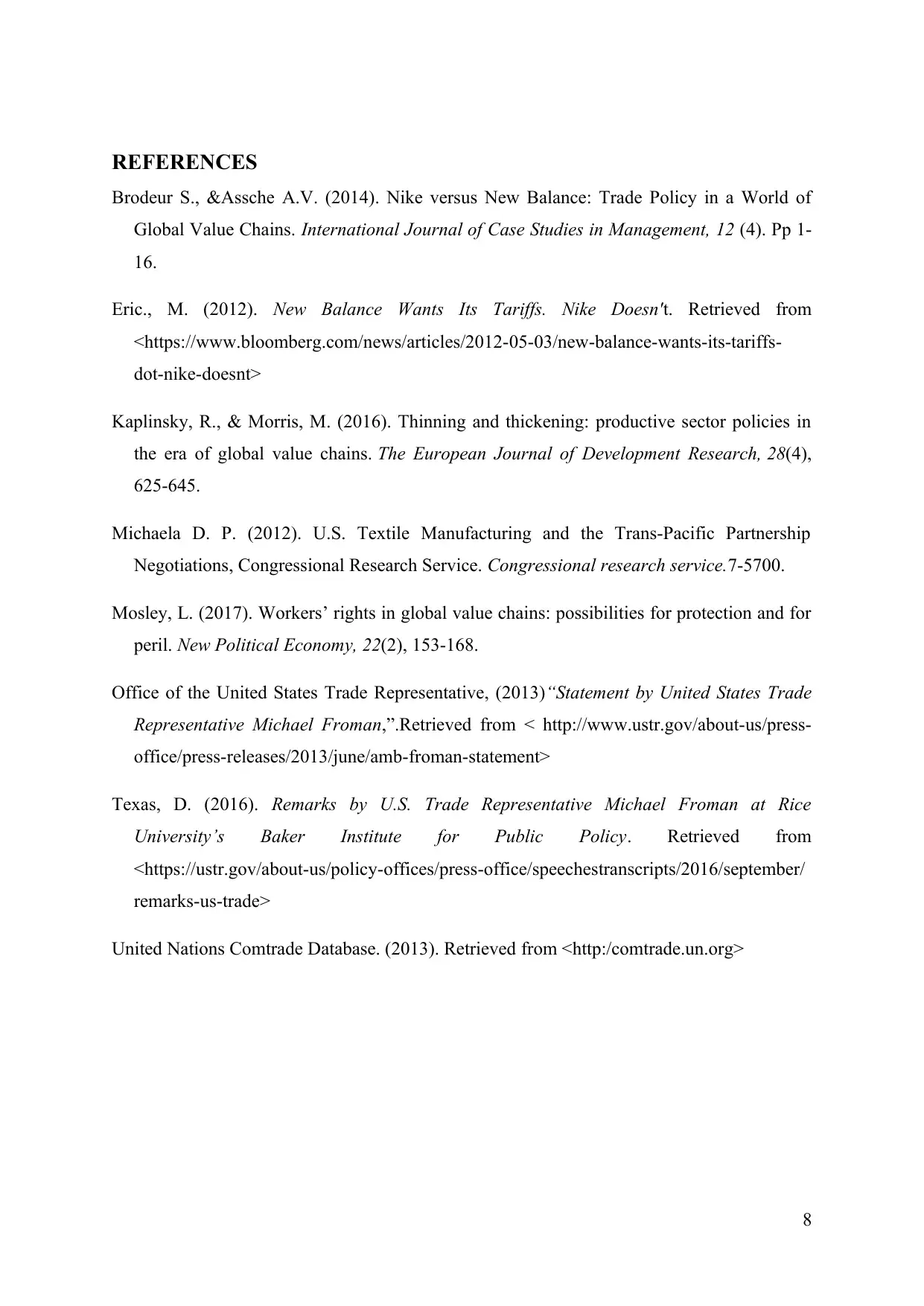
REFERENCES
Brodeur S., &Assche A.V. (2014). Nike versus New Balance: Trade Policy in a World of
Global Value Chains. International Journal of Case Studies in Management, 12 (4). Pp 1-
16.
Eric., M. (2012). New Balance Wants Its Tariffs. Nike Doesn't. Retrieved from
<https://www.bloomberg.com/news/articles/2012-05-03/new-balance-wants-its-tariffs-
dot-nike-doesnt>
Kaplinsky, R., & Morris, M. (2016). Thinning and thickening: productive sector policies in
the era of global value chains. The European Journal of Development Research, 28(4),
625-645.
Michaela D. P. (2012). U.S. Textile Manufacturing and the Trans-Pacific Partnership
Negotiations, Congressional Research Service. Congressional research service.7-5700.
Mosley, L. (2017). Workers’ rights in global value chains: possibilities for protection and for
peril. New Political Economy, 22(2), 153-168.
Office of the United States Trade Representative, (2013)“Statement by United States Trade
Representative Michael Froman,”.Retrieved from < http://www.ustr.gov/about-us/press-
office/press-releases/2013/june/amb-froman-statement>
Texas, D. (2016). Remarks by U.S. Trade Representative Michael Froman at Rice
University’s Baker Institute for Public Policy. Retrieved from
<https://ustr.gov/about-us/policy-offices/press-office/speechestranscripts/2016/september/
remarks-us-trade>
United Nations Comtrade Database. (2013). Retrieved from <http:/comtrade.un.org>
8
Brodeur S., &Assche A.V. (2014). Nike versus New Balance: Trade Policy in a World of
Global Value Chains. International Journal of Case Studies in Management, 12 (4). Pp 1-
16.
Eric., M. (2012). New Balance Wants Its Tariffs. Nike Doesn't. Retrieved from
<https://www.bloomberg.com/news/articles/2012-05-03/new-balance-wants-its-tariffs-
dot-nike-doesnt>
Kaplinsky, R., & Morris, M. (2016). Thinning and thickening: productive sector policies in
the era of global value chains. The European Journal of Development Research, 28(4),
625-645.
Michaela D. P. (2012). U.S. Textile Manufacturing and the Trans-Pacific Partnership
Negotiations, Congressional Research Service. Congressional research service.7-5700.
Mosley, L. (2017). Workers’ rights in global value chains: possibilities for protection and for
peril. New Political Economy, 22(2), 153-168.
Office of the United States Trade Representative, (2013)“Statement by United States Trade
Representative Michael Froman,”.Retrieved from < http://www.ustr.gov/about-us/press-
office/press-releases/2013/june/amb-froman-statement>
Texas, D. (2016). Remarks by U.S. Trade Representative Michael Froman at Rice
University’s Baker Institute for Public Policy. Retrieved from
<https://ustr.gov/about-us/policy-offices/press-office/speechestranscripts/2016/september/
remarks-us-trade>
United Nations Comtrade Database. (2013). Retrieved from <http:/comtrade.un.org>
8
1 out of 8
Your All-in-One AI-Powered Toolkit for Academic Success.
+13062052269
info@desklib.com
Available 24*7 on WhatsApp / Email
![[object Object]](/_next/static/media/star-bottom.7253800d.svg)
Unlock your academic potential
© 2024 | Zucol Services PVT LTD | All rights reserved.


